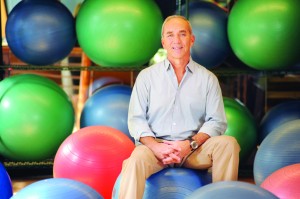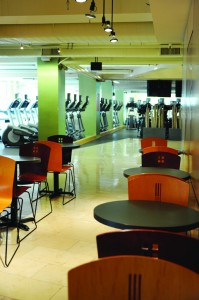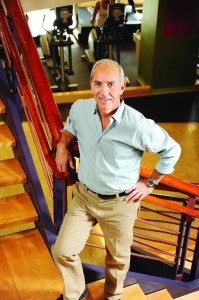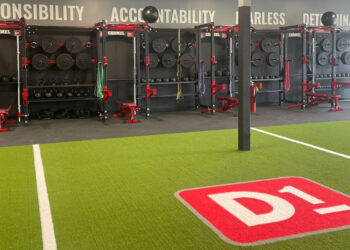How Mark Harrington and Healthworks have prospered by perfecting a niche and serving the Greater Boston community.

BACK TO THE BEGINNING
In what must seem like a previous life, Mark Harrington, president of Healthworks Fitness Centers for Women, was involved in site selection for commercial real estate – specifically shopping centers. During this early part of his career, Harrington learned a lot about retail success and failure – knowledge he brought along to Healthworks in 1978 when he opened the company’s first location in Salem, Mass. “I think my background in real estate allowed me to take a different approach to opening a club,” he said. “Back then, concepts like ‘efficiency for location’ and ‘revenue per square foot’ were not things most people looked at when opening a fitness club.”
From the beginning, Healthworks Fitness Centers for Women was obviously targeting a niche market. Harrington understood the importance of maximizing the number of people who could effectively use the club at one time and applied what he had learned from other successful retailers to every area of the club. The goal was to create an experience that allowed members to flow in and out of the club with no traffic jams or bottlenecks. “The successful retailers I worked with had a sense of purpose,” he shared. “They knew it was imperative to execute a bunch of small, simple tasks flawlessly, which is more difficult than it sounds.”
In evaluating other women-only clubs, Harrington perceived shortcomings in amenities, size and service, so his goal from the beginning was to give women what they really wanted and needed from a health and fitness club. Harrington said his first location contained the same basic offerings that Healthworks offers to this day (cardio, strength, group ex, day care), but at only 6,000 square feet it soon became clear that a larger facility was in order, partly due to the costs of payroll and occupancy.
Today, Harrington owns seven locations in the Greater Boston area – two of which are not for profit – and they range up to 35,000 square feet in size. “Many people wondered why anyone would open a women-only club and exclude such a large part of the population from the outset, but that was before we as an industry understood the appeal of niche facilities,” Harrington said. “I felt women wanted more from a fitness club than a storefront and I understood the importance of the efficiencies provided by a larger facility, as well as how it comes through in the pricing.”
A CHALLENGE MET
In 1997, Harrington opened his fourth location in the center of Boston. Shortly thereafter, in the midst of what was otherwise a prosperous and happy time for the company, a lawsuit was brought against Healthworks. The sole purpose of the suit was to prove what the company was doing (serving women only) was illegal. During the year Harrington spent in the court system fighting for the Healthworks concept, he was overwhelmed by the outpouring of public support the company received. “It really became bigger than our little lawsuit,” he recalled. “Some people felt we were treading on a slippery slope – we were featured on 60 Minutes!”
Harrington pointed out that women-only fitness centers are not merely about excluding men. They are about providing a place where all women can work out and in a safe environment. The concept appealed to the everyday exerciser, women with certain religious beliefs and those who have suffered from abuse. “Unfortunately, we were found to be in violation of the State’s Public Accommodations law,” he said. “So we attempted to go to the State House and have the law amended.” The goal was to create an exception for the law – not just for women’s fitness centers, but to allow for single-gender facilities, period. Harrington and his team were ultimately successful and since then similar laws have been passed in 10 other states.

THE GREATER GOOD
Harrington said the experience of going through a legal battle made him re-visit his priorities in life. In reality, the public support for his cause, as simply as it started out, allowed him to recognize that he was in fact impacting women’s lives in such a positive way. After spending several hundred-thousand dollars to defend his clubs and witnessing how many people had been touched as a result, Harrington created The Healthworks Foundation in 1998. Inspired by the concept of ‘Women Helping Women,’ the foundation had two major purposes: Bring fitness to women living in the inner city and low-income communities and create community outreach programs which create opportunities for our membership base to become involved in other charitable ventures.
“Mere survival is often a primary concern of people living in the areas the foundation serves,” Harrington said. “Many people want to get involved and help, but they don’t always know how or where to do it, so we want to be that place.” Creating the foundation has also brought a greater sense of purpose to the clubs – much of the money that is donated comes from membership dues at the Healthworks for-profit locations. The Healthworks Foundation now has two non-profit clubs in Dorcester, Mass. that service homeless women, teen moms and low-income residents, as well as their children. Harrington said the foundation clubs have taught the company much about the importance of having a sense of purpose and finding commonality to create closeness among members.
MASTERING A MARKET
The Healthworks member profile is made up mostly of women between the ages of 24 and 49 who are fit and who actually use the clubs, making it even more important to properly manage traffic flow and space concerns. In a nutshell, Healthworks Fitness for Women is a niche club that prides itself on offering the women-only experience in a spacious format with high-end amenities, very nice finishes and exceptional programming. Harrington’s understanding of size allows the company to offer this experience at a mid-level price point, which is also aided by the high volume each club experiences. In addition, Healthworks offers a very wide variety in its group ex programming – something Harrington said women have demonstrated they really wanted to see.
“Today, people in the urban markets are so busy they often just want to get in, work out and get on with the rest of their lives,” he said. “This makes it very important to remain focused on efficiency and to consciously serve our niche market.” For Healthworks, this has meant designing the clubs to suit women in every way – lots of colors, fresh flowers, cleanliness and high-end finishes like limestone showers and full-length lockers are just some of the extra touches that make the clubs comfortable and create an atmosphere women want to return to again and again.

REACHING THE AUDIENCE
“I truly believe in the rewards of having a smaller company and being closer to the staff and the community – these things can become more difficult with a larger company,” said Harrington. “Now that we are established in one market with a known brand, much of our marketing happens through existing members.” The company offers many incentives, including guest passes, a referral program and open houses for current members to bring in friends, but it is also not afraid to try new ways to create a buzz.
Fiona’s Challenge is a great example of one of Healthworks’ more out-of-the-box initiatives. Currently in full swing, this creative and successful attempt to create excitement in the club encourages members to partner with women who are not yet members. Each team has six to 10 participants and competes for a chance to win a $1,500 shopping spree to City Sports. ‘Fiona’ is a fictitious character created by Healthworks to encourage the teams and to allow a variety of concepts to flow through to members. “It’s actually taken on a life of it’s own,” Harrington said. “This is all part of the sense of community we’re trying to build here.”
Externally, Healthworks does basic brand advertising on buses, in subways and via social networking on Facebook and Twitter. ‘Fiona’ posts health and fitness information in these locations as well as on the company’s Web site, helping to create a greater online community around the clubs.
INTO THE FUTURE
“There is a tremendous opportunity with the economic downturn,” Harrington shared. “High rents used to keep clubs out of urban areas, but they have been coming down recently, presenting one of the greatest opportunities in years.” Healthworks plans to open at least one new club over the next year or so but remains focused on quality, not quantity. They have a very small corporate office for a reason – everyone is expected to get out in the clubs as much as possible. “You can learn so much from your members if you just listen,” said Harrington. “One of our main objectives is to make a raving fan out of an unhappy member.”
As for the current state of the economy and the coming year, Harrington urges club owners to keep a level head and focus on what they do best. “Don’t get overly excited when something is great, or overly worried when things are bad,” he said. “What is the core of your business? Perhaps it’s time to reinvent yourself within the confines of your market and what it will bear.” – CS









I LOVE Healthworks!……Its the best club I ever been……….everythings its perfect!..Mr Harrington is really doing a great job!